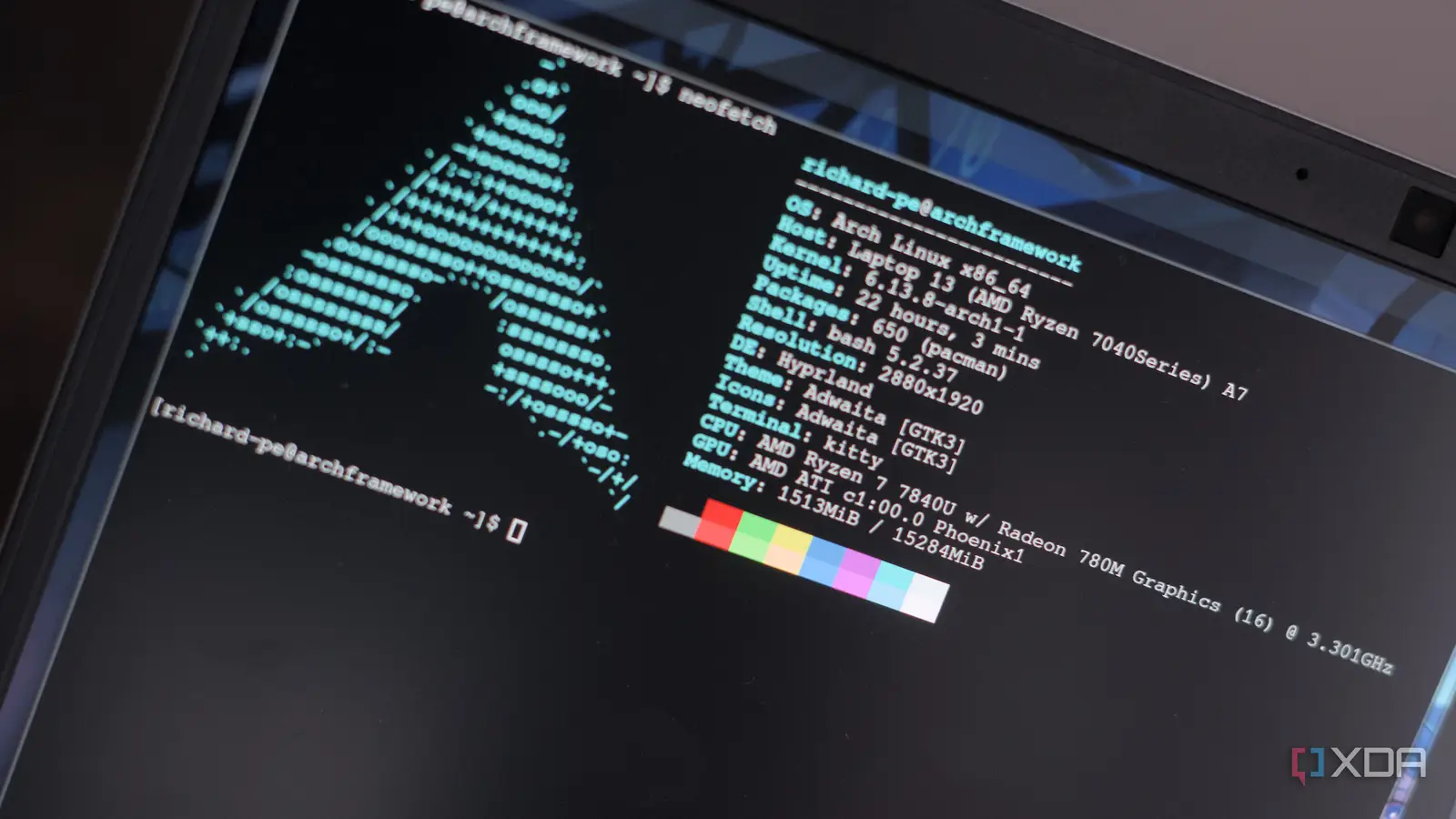Copyright XDA Developers

I'll be upfront; I don't have a lot of experience with Linux. I started my journey with Linux Mint around five months ago, back when I was a Windows fanboy. Since then, I have moved and settled on Fedora KDE Plasma. When I run an article discussing my Linux findings, people in the comments are quick to bring up Arch Linux. Sometimes they mention something like endeavourOS, and sometimes they just flat-out recommend Arch itself. It got to the point where I was curious about Arch Linux. And yes, I could install something like EndeavourOS and call it a day, but I really wanted to see if I could get the base Arch Linux working on my spare laptop. If push comes to shove and everything blows up in my face, the worst-case scenario is that I just use EndeavourOS instead. So, let's dive in and see what happens! Step 1: Learning to RTFM (Regard The Friendly Man) That's what that acronym means, right? To get started, I headed over to the Arch Linux website and loaded a USB drive with the ISO. I then popped it into my spare laptop, booted off the USB stick, and waited. Usually, Linux installers are, essentially, demos for the distro. You get a lighter version of the OS to toy around with, and while it's kind of slow and you can't do a lot with it, it acts as a nice taster for what you're about to install. Arch Linux? No demo. In fact, what I saw when I booted off the USB was just a blinking command line. The installer was giving me a very clear message: I wanted to install Arch Linux, I had to roll up my sleeves and get stuck in. Fortunately, Arch Linux doesn't just throw a command line at you and wish you luck. As you can see in the photo above, there's a whole setup guide that teaches you how to get everything done. You're going to need a secondary device to read it, because the installer doesn't have a browser to read it from. Hell, it doesn't have internet; you have to manually enter the commands to connect to your router through commands before you can even ping anything. Oh, and just a tip: when you do connect to your router and ping something, you can end the ping command by pressing CTRL+C. I learned that the hard way as I tried to stop my laptop from performing the weakest DDoS known to man on Arch Linux's servers because I didn't limit it. RTFMing the wiki was a great starting point, but I also found another way to RTFM, which is to Regard The Friendly Man. In this case, the friendly man was Ermanno Ferrari, who made a YouTube video on setting up Arch Linux. The video is five years old, so some things acted differently with my copy of Arch Linux, but if anything weird happened, it was simply a Google search away from learning what I should do. Ermanno was especially helpful with the partitioning step, where you have to tell Arch Linux what partitions you want manually. It was probably the hardest part of the pre-installation. Step 2: Installing Arch Linux Realizing the power I had Yes, I said "pre-installation" because I hadn't actually installed anything. All I had done was lay the foundation for the installation: establishing an internet connection, setting the timezone, and partitioning my drive. Linux hadn't even landed on my system, and I already felt like I had gone through a learning process or two getting here. The installation process is where I started to realize why people love this OS so much. Because I'm an Arch Linux newbie, I just followed the guides; my end goal was to get something working. However, there were moments where I was given a choice between different things, where I didn't explore my options because I was following the guide. It's like when you're being taken around a tour by a tour guide, following the approved path, but taking mental note of all the stuff you want to revisit and check out later. For example, the written manual recommends you install "a basic installation with the Linux kernel and firmware for common hardware" with the command "# pacstrap -K /mnt base linux linux-firmware." It felt like I could really mess around with that command and see what else I could do, like install something else other than the regular Linux kernel. Similarly, Ermanno Ferrari discussed installing GNOME and KDE Plasma during the setup, and because I'm familiar with Fedora KDE Plasma, that felt like a no-brainer to go with. However, I could have installed something else here. In short, there was a lot of room to experiment, but because I was in "get this thing working" mode, I didn't mess with anything past what was needed. Besides those checkpoints, this stage was all about getting the system nitty-gritty done, such as creating user accounts and tweaking the system files to represent what I wanted properly. Again, doing both kinds of RTFM helped me out here. Step 3: Using Arch Linux A lot easier than I thought it'd be I finally had an Arch Linux install ready to go, so I rebooted and logged in using KDE Plasma. After all the setup I had to do, I expected the world of Arch Linux to be a strange, alien place, where the very thought of installing something like Google Chrome would mean a mammoth undertaking. Then I remembered that Flatpak is a thing that exists, and I could literally boot up KDE Discover and install everything I wanted with a few clicks. I felt that was a little too boring, so I instead opted not to use Flatpak and figure out how I'd install Google Chrome without it. After all, the Chrome website doesn't have an Arch Linux download on its website, and I wanted to learn how people would install it if they didn't want to install Flatpak. After some research, I learned about the Arch User Repository (AUR), alongside one of the more popular AUR helpers, Yet Another Yogurt (YAY). After installing all the bits and pieces, I could now tap into the AUR and install any app I like from there. For example, "yay -S google-chrome" would download Chrome and get it all set up for me. Nice. After that, it was just a case of looking up how to get something done and using pacman to install any missing bits and pieces that I discovered along the way. And once I was done, I had an OS that I had built up from just a command line. Sure, I had to have two sources guide me through it, but I still did it, dangit. I think I can get used to this "Arch" thing Apologies if you clicked on this article expecting to read someone get furious over having to use a terminal to install an operating system; however, I did really enjoy setting up and using Arch Linux. While I needed plenty of handholding during the setup and installation phase, I learned a lot by reading the documentation and figuring out why I was typing the commands I had to type. When I approached Arch Linux, I made sure I wasn't being too adventurous, but now I feel like I wasn't being adventurous enough. I'll keep toying with Arch Linux with KDE Plasma and see how it fares, and if I get bored, I might try the installation process again, this time with a separate home directory and a new desktop environment that I haven't tried yet. But as for now, as an ex-Windows fanboy giving it a go...yeah, I get you, Arch Linux fans. I get you.



